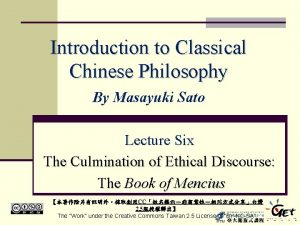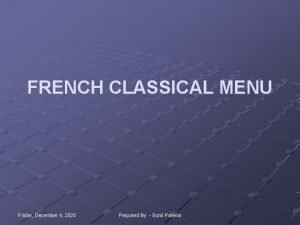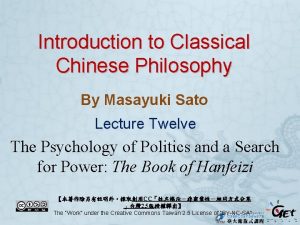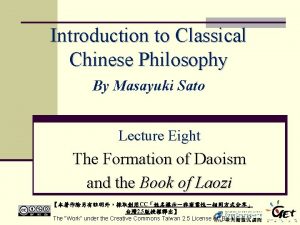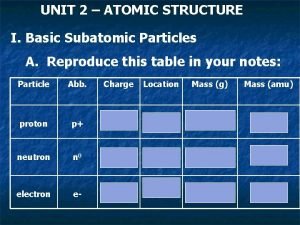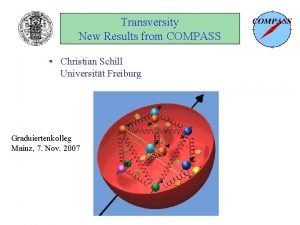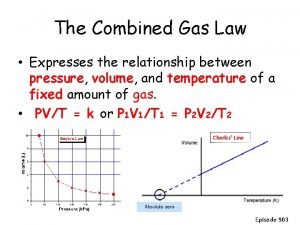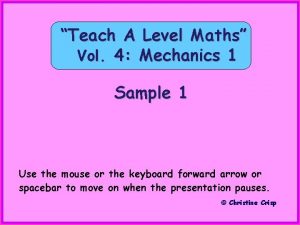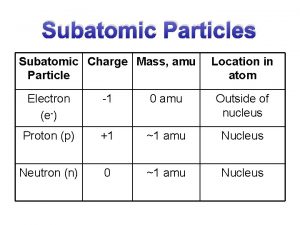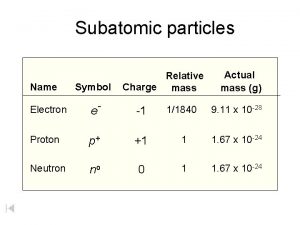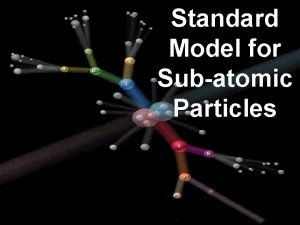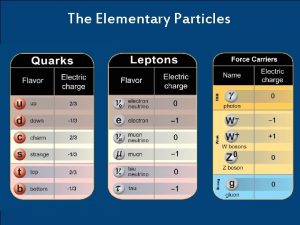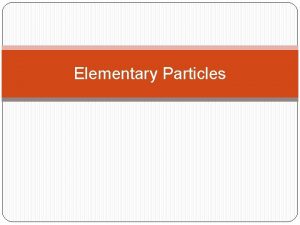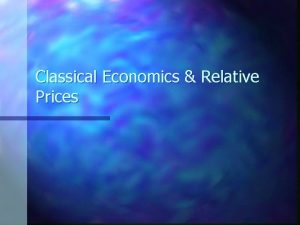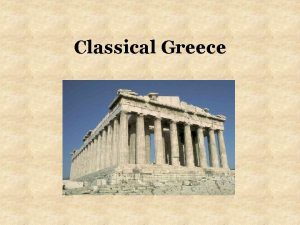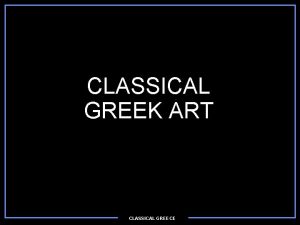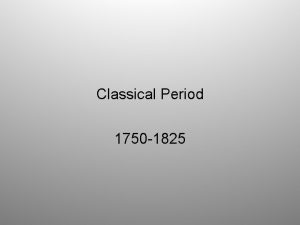Historical Introduction to the Elementary Particles THE CLASSICAL


















- Slides: 18

Historical Introduction to the Elementary Particles

THE CLASSICAL ERA (1 897 -1 932) • The elementary particle physics was born in 1897, with J. J. Thomson’s discovery of the electron. • 1. Thomson knew That cathode rays emitted by a hot filament could be deflected by a magnet. This suggested that they carried electric charge; • 2. in fact, the direction of the curvature required that the charge be negative. • 3. It seemed, therefore, that these were not rays at all, but rather streams of particles. • 4. By passing the beam through electric and magnetic fields, and adjusting the field strength until the net deflection was zero, Thomson was able to determine the velocity of the particles as well as their charge-to mass ratio. This ratio turned out to be enormously greater than for any known ion, indicating that either the charge was extremely large or the mass was very small. Indirect evidence pointed to the second conclusion. • 5. Thomson called the particles corpuscles, and their charge the electron. Later the word electron was applied to the particles themselves.

• 6. Thomson correctly surmised that these electrons were essential constituents of atoms; however, since atoms as a whole are electrically neutral and very much heavier than electrons, there immediately arose the problem of how the compensating plus charge and the bulk of the mass-is distributed within an atom. • 7. Thomson himself imagined that the electrons were suspended in a heavy, positively charged paste, . But Thomson’s model was decisively repudiated by Rutherford’s famous scattering experiment, which showed that the positive charge, and most of the mass, was concentrated in a tiny core, or nucleus, at the center of the atom.

• Rutherford demonstrated this by firing a beam of a particles (ionized helium atoms) into a thin sheet of gold foil had the gold atoms consisted of rather diffuse spheres, as Thomson supposed, then all of the a-particles should have been deflected a bit, but none would have been deflected much any more than a bullet is deflected much when it passes, say, through a bag of sawdust. What in fact occurred was that most of the Alfa particles passed through the gold completely undisturbed, but a few of them bounced off at wild angles. Rutherford’s conclusion was that the • 1. Alfa particles had encountered something very small, very hard, and very heavy. • 2. Evidently the positive charge, • 3. and virtually all of the mass, was concentrated at the center, occupying only a tiny fraction of the volume of the atom • 4. (the electrons are too light to play any role in the scattering; they are knocked right out of the way by the much heavier a-particles).

• 5. The nucleus of the lightest atom (hydrogen) was given the name proton by Rutherford. In 1914 Niels Bohr • 1. proposed a model for hydrogen consisting of a single electron circling the proton, held in orbit by the mutual attraction of opposite charges. • 2. Using a primitive version of the quantum theory, Bohr was able to calculate the spectrum of hydrogen, and the agreement with experiment was nothing short of spectacular. It was natural then to suppose that the nuclei of heavier atoms were composed of two or more protons bound together, supporting a like number of orbiting electrons.

• Unfortunately, the next heavier atom (helium), although it does indeed carry two electrons, weighs four times as much as hydrogen, and lithium (three electrons) is seven times the weight of hydrogen, and so it goes. This dilemma was finally resolved in 1932 with Chadwick‘s discovery of the neutron-an electrically neutral twin to the proton. The helium nucleus, it turns out, contains two neutrons in addition to the two protons; lithium evidently includes four; and in general the heavier nuclei carry very roughly the same number of neutrons as protons. (The number of neutrons is in fact somewhat flexible: the same atom, chemically speaking, may come in several different isotopes, all with the same number of protons, but with varying numbers of neutrons. )

• The discovery of the neutron put the final touch on what we might call the classical period in elementary particle physics. Never before has physics offered so simple and satisfying an answer to the question, “What is matter made of? ” In 1932 it was all just protons, neutrons, and electrons.

1. 2 THE PHOTON (1 900 -1 924) • it’s hard to say exactly when or by whom the photon was really “discovered, ” although the essential stages in the process are clear enough. • 1. The first contribution was made by Planck in 1900. Planck was attempting to explain the socalled blackbody spectrum for the electromagnetic radiation emitted by a hot object. Statistical mechanics, which had proved brilliantly successful in explaining othermal processes, yielded nonsensical results when applied to electromagnetic fields. In particular, it led to the famous “ultraviolet catastrophe , ”

• predicting that the total power radiated should be infinite. Planck found that he could escape the ultraviolet catastrophe and fit the experimental curve if he assumed that electromagnetic radiation is quantized, coming in little “packages” of energy E = hv • where v is the frequency of the radiation and h is a constant, which Planck adjusted to fit the data. Planck did not profess to know why the radiation was quantized; he assumed that it was due to a peculiarity in the emission process: For some reasons a hot surface only gives off light in little squirts. • 2. Einstein, in 1905, put forward a far more radical view. He argued that quantization was a feature of the electromagnetic field itself, having nothing to do with the emission mechanism.

• With this new twist, Einstein adapted Planck’s idea, and his formula, to explain the photoelectric effect: When electromagnetic radiation strikes a metal surface, electrons come popping out. Einstein suggested that an incoming light quantum hits an electron in the metal, giving up its energy (hn); the excited electron then breaks through the metal surface, losing in the process an energy w (the so called work function of the material an empirical constant that depends on the particular metal involved).

• The electron thus emerges with an energy E< =hn-w • (It may lose some energy before reaching the surface. That’s the reason for using <, instead of =. ) Einstein’s formula is pretty trivial to derive, but it carries an extraordinary implication: The maximum electron energy is independent of the intensity of the light and depends only on its color (frequency). To be sure, a more intense beam will knock out more electrons, but their energies will be the same.

• Unlike Planck’s theory, Einstein’s theory met a hostile reception, and over the next 20 years he was to wage a lonely battle for the light quantum. In saying that electromagnetic radiation is by its nature quantized, regardless of the emission mechanism, Einstein came dangerously close to resurrecting the discredited particle theory of light. Newton, of course, had introduced such a corpuscular model, but a major achievement of nineteenth century physics was the decisive repudiation of Newton’s idea in favor of the rival wave theory.

• No one was prepared to see that accomplishment called into question, even when the experiments came down on Einstein’s side. • 3. In 1916 Millikan completed an exhaustive study of the photoelectric effect and was obliged to report that “Einstein’s photoelectric equation. . . appears in every case to predict exactly the observed results. What finally settled the issue was an experiment conducted • 4. by A. H. Compton in 1923. Compton found that the light scattered from a particle at rest is shifted in wavelength, according the equation l‘ =l+ lc(l - cos q) where l is the incident wavelength, l‘ is the scattered wavelength, q is the scattering angle, and lc= h/mc

• is the so-called Compton wavelength of the target particle (mass m). Now, this is precisely the formula you get if you treat light as a particle of zero rest mass with energy given by Planck‘s equation, and apply the laws of conservation of (relativistic) energy and momentum just as you would for an ordinary elastic collision. That clinched it; here was direct and incontrovertible experimental evidence that light behaves as a particle, on the sub-atomic scale. • 5. we call this particle the photon (a name suggested by the chemist Gilbert Lewis, in 1926); the symbol for a photon is g (from gamma ray).

• Although the photon initially forced itself on an unreceptive community of physicists, it eventually found a natural place in quantum field theory, and was to offer a whole new perspective on electromagnetic interactions. In classical electrodynamics, we attribute the electrical repulsion of two electrons, say, to the electric field surrounding them; each electron contributes to the field, and each one responds to the field. But in quantum field theory, the electric field is quantized (in the form of photons),

• and we may picture the interaction as consisting of a stream of photons passing back and forth between the two charges, each electron continually emitting them and continually absorbing them. And the same goes for any noncontact force: where classically we interpret “action at a distance” as “mediated” by afield, we now say that it is mediated by an exchange of particles (the quanta of the field). In the case of electrodynamics, the mediator is the photon; for gravity, it is called the graviton (though a fully successful quantum theory of gravity has yet to be developed and it may well be centuries before anyone detects a graviton experimentally).

• You will see later on how these ideas are implemented in practice, but for now I want to dispel one common misapprehension. When I say that every force is mediated by the exchange of particles , I am not speaking of a merely kinematic phenomenon. Two ice skaters throwing snowballs back and forth will of course move apart with the succession of recoils; they “repel one another by exchange of snowballs, ” if you like. But that’s not what is involved here. For one thing , this mechanism would have a hard time accounting for an attractive force.

• You might think of the mediating particles, rather, as “messengers, ” and the message can just as well be “come a little closer” as “go away. ” I said earlier that in the “classical” picture ordinary matter is made of atoms, in which electrons are held in orbit around a nucleus of protons and neutrons by the electrical attraction of opposite charges. We can now give this model a more sophisticated formulation by attributing the binding force to the exchange of photons between the electrons and the protons in the nucleus. However, for the purposes of atomic physics this is overkill, for in this context quantization of the electromagnetic field produces only minute effects (notably the Lamb shift and the anomalous magnetic moment of the electron). To excellent approximation we can pretend that the forces are given by Coulomb’s law (together with various magnetic dipole couplings). The point is that in a bound state enormous numbers of photons are continually streaming back and forth, so that the “lumpiness” of the field is effectively smoothed out, and classical electrodynamics is a suitable approximation to the truth. But in most elementary particle processes, such as the photoelectric effect or Compton scattering, individual photons are involved, and quantization can no longer be ignored.
 Elementary particles
Elementary particles Classification of elementary particles
Classification of elementary particles Introduction to classical chinese philosophy
Introduction to classical chinese philosophy Second course of french classical menu
Second course of french classical menu Napolitine
Napolitine Introduction to classical chinese philosophy
Introduction to classical chinese philosophy Introduction to classical chinese philosophy
Introduction to classical chinese philosophy Self introduction for elementary students
Self introduction for elementary students Introduction to elementary statistics
Introduction to elementary statistics Project on an elementary school classroom in a slum
Project on an elementary school classroom in a slum Literary devices in elementary school classroom in a slum
Literary devices in elementary school classroom in a slum Solid+heat
Solid+heat Atom and subatomic particles
Atom and subatomic particles Point like particles
Point like particles Calcium subatomic particles
Calcium subatomic particles What is the combined gas law
What is the combined gas law Connected particles a level maths
Connected particles a level maths Mass of subatomic particles in amu
Mass of subatomic particles in amu Subatomic particles symbol
Subatomic particles symbol


